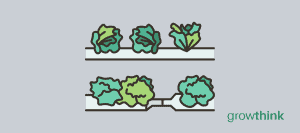Over the past 20+ years, we have helped over 3,500 farmers create business plans to start and grow their farm businesses. On this page, we will first give you some background information with regards to the importance of business planning. We will then go through a farm business plan template step-by-step so you can create your plan today.
What is a Farm Business Plan?
A business plan provides a snapshot of your farm business as it stands today, and lays out your growth plan for the next five years. It explains your business goals and your strategy for reaching them. It also includes market research to support your plans.
Why You Need a Business Plan for a Farm
If you’re looking to start a farm business or grow your existing farm business you need a business plan. A business plan will help you raise funding, if needed, and plan out the growth of your farm business in order to improve your chances of success. Your farm business plan is a living document that should be updated annually as your company grows and changes. It can be used to create a vegetable farm business plan, or a dairy farm, produce farm, fruit farm, agriculture farm and more.
Source of Funding for Farm Businesses
With regards to funding, the main sources of funding for a farm business are personal savings, bank loans and angel investors. With regards to bank loans, banks will want to review your business plan and gain confidence that you will be able to repay your loan and interest. To acquire this confidence, the loan officer will not only want to confirm that your financials are reasonable. But they will want to see a professional plan. Such a plan will give them the confidence that you can successfully and professionally operate a business.
The second most common form of funding for a farm business is angel investors. Angel investors are wealthy individuals who will write you a check. They will either take equity in return for their funding, or, like a bank, they will give you a loan.
Finish Your Business Plan Today!
If you’d like to quickly and easily complete your business plan, download Growthink’s Ultimate Farm Business Plan Template and complete your plan and financial model in hours.
Farm Business Plan Template
Your business plan should include 10 sections as follows:
Executive Summary
Your executive summary provides an introduction to your business plan, but it is normally the last section you write because it provides a summary of each key section of your plan.
The goal of your Executive Summary is to quickly engage the reader. Explain to them the type of farm business you are operating and the status; for example, are you a startup, do you have a farm business that you would like to grow, or are you operating a chain of farm businesses.
Next, provide an overview of each of the subsequent sections of your plan. For example, give a brief overview of the farm business industry. Discuss the type of farm business you are operating. Detail your direct competitors. Give an overview of your target customers. Provide a snapshot of your marketing plan. Identify the key members of your team. And offer an overview of your financial plan.
Company Analysis
In your company analysis, you will detail the type of farm business you are operating.
For example, you might operate one of the following types among others:
- Vegetable Farm: this type of farm grows a wide variety of vegetables (but not grains or soybeans) and melons in open fields and in greenhouses.
- Dairy Farm: this type of farm primarily raises cattle for milk. Typically, this type of farm does not process the milk into cheeses or butter, etc.
- Fruit Farm: this type of farm primarily grows fruits.
- Hay and Crop Farm: More than half of these types of farms grow hay, while a small number grow sugar beets. A variety of other crops, such as hops and herbs, are included in the industry. Some operators also gather agave, spices, tea and maple sap.
- Industrial Hemp Farm: this type of farm grows and harvests cannabis plants with a tetrahydrocannabinol (THC) content of less than 0.3% by weight.
- Plant & Flower Farm: this type of farm grows nursery plants, such as trees and shrubs; flowering plants, such as foliage plants, cut flowers, flower seeds and ornamentals; and short rotation woody trees, such as Christmas trees and cottonwoods.
- Vertical Farming: This type of farm involves growing crops in vertically stacked layers, often using controlled environment agriculture (CEA) technologies. This method dramatically reduces the amount of land space needed for farming and can increase crop yields.
In addition to explaining the type of farm business you operate, the Company Analysis section of your business plan needs to provide background on the business.
Include answers to question such as:
- When and why did you start the business?
- What milestones have you achieved to date? Milestones could include sales goals you’ve reached, acquisition of additional acreage, etc.
- Your legal structure. Are you incorporated as an S-Corp? An LLC? A sole proprietorship? Explain your legal structure here.
Industry Analysis
In your industry analysis, you need to provide an overview of the farm business.
While this may seem unnecessary, it serves multiple purposes.
First, researching the farm business industry educates you. It helps you understand the market in which you are operating.
Secondly, market research can improve your strategy particularly if your research identifies market trends. For example, if there was a trend towards decaffeinated farm business consumption, it would be helpful to ensure your plan calls for plenty of decaffeinated options.
The third reason for market research is to prove to readers that you are an expert in your industry. By conducting the research and presenting it in your plan, you achieve just that.
The following questions should be answered in the industry analysis section of your farm business plan:
- How big is the farm business (in dollars)?
- Is the market declining or increasing?
- Who are the key competitors in the market?
- Who are the key suppliers in the market?
- What trends are affecting the industry?
- What is the industry’s growth forecast over the next 5 – 10 years?
- What is the relevant market size? That is, how big is the potential market for your farm business. You can extrapolate such a figure by assessing the size of the market in the entire country and then applying that figure to your local population.
Customer Analysis
The customer analysis section of your farm business plan must detail the customers you serve and/or expect to serve.
The following are examples of customer segments: food manufacturers, grocery wholesalers, retail grocers, restaurants, individual consumers, etc.
As you can imagine, the customer segment(s) you choose will have a great impact on the type of farm business you operate. Clearly food manufacturers would want different pricing and product options, and would respond to different marketing promotions than retail grocers.
Psychographic profiles explain the wants and needs of your target customers. The more you can understand and define these needs, the better you will do in attracting and retaining your customers.
Finish Your Farm Business Plan in 1 Day!
Don’t you wish there was a faster, easier way to finish your business plan?
With Growthink’s Ultimate Farm Business Plan Template you can finish your plan in just 8 hours or less!
Click here to finish your Farm business plan today.
Competitive Analysis
Your competitive analysis should identify the indirect and direct competitors your business faces and then focus on the latter.
Direct competitors are other farm businesses.
Indirect competitors are other options that customers have to purchase from that aren’t direct competitors. This includes processed foods, imported goods, and growing produce themselves. You need to mention such competition to show you understand the true nature of the market.
With regards to direct competition, you want to detail the other farm businesses with which you compete. Most likely, your direct competitors will be farm businesses located very close to your location.
For each such competitor, provide an overview of their businesses and document their strengths and weaknesses. Unless you once worked at your competitors’ businesses, it will be impossible to know everything about them. But you should be able to find out key things about them such as:
- What types of customers do they serve?
- What products do they offer?
- What is their pricing (premium, low, etc.)?
- What are they good at?
- What are their weaknesses?
With regards to the last two questions, think about your answers from the customers’ perspective. And don’t be afraid to ask your competitors’ customers what they like most and least about them.
The final part of your competitive analysis section is to document your areas of competitive advantage. For example:
- Will you provide superior products?
- Will you provide products that your competitors don’t offer?
- Will you make it easier or faster for customers to acquire your products?
- Will you provide better customer service?
- Will you offer better pricing?
Think about ways you will outperform your competition and document them in this section of your plan.
Marketing Plan
Traditionally, a marketing plan includes the four P’s: Product, Price, Place, and Promotion. For a farm business plan, your marketing plan should include the following:
Product: in the product section you should reiterate the type of farm business that you documented in your Company Analysis. Then, detail the specific products you will be offering. For example, in addition to wholesale crops, will you also offer subscriptions to individuals?
Price: Document the prices you will offer and how they compare to your competitors. Essentially in the product and price sub-sections of your marketing plan, you are presenting the products you offer and their prices.
Place: Place refers to the location of your farm. Document your location and mention how the location will impact your success. For example, is your farm centrally located near gourmet restaurants and specialty grocers, etc. Discuss how your location might provide a steady stream of customers. Also, if you operate or plan to operate farm stands, detail the locations where the stands will be placed.
Promotions: the final part of your farm business marketing plan is the promotions section. Here you will document how you will drive customers to your location(s). The following are some promotional methods you might consider:
- Making your farm stand extra appealing to attract passing customers
- Distributing produce samples from the farm stand or at farmers markets
- Advertising in local papers and magazines
- Reaching out to local bloggers and websites
- Flyers
- Local radio advertising
- Banner ads at local venues
Finish Your Business Plan Today!
If you’d like to quickly and easily complete your business plan, download Growthink’s Ultimate Farm Business Plan Template and complete your plan and financial model in hours.
Operations Plan
While the earlier sections of your business plan explained your goals, your operations plan describes how you will meet them. Your operations plan should have two distinct sections as follows.
Everyday short-term processes include all of the tasks involved in running your farm business such as serving customers, delivering produce, harvesting, etc.
Long-term goals are the milestones you hope to achieve. These could include the dates when you expect to serve your 1,000th customer, or when you hope to reach $X in sales. It could also be when you expect to hire your Xth employee or acquire more arable land.
Management Team
To demonstrate your farm business’s ability to succeed as a business, a strong management team is essential. Highlight your key players’ backgrounds, emphasizing those skills and experiences that prove their ability to grow a company.
Ideally you and/or your team members have direct experience in farming. If so, highlight this experience and expertise. But also highlight any experience that you think will help your business succeed.
If your team is lacking, consider assembling an advisory board. An advisory board would include 2 to 8 individuals who would act like mentors to your business. They would help answer questions and provide strategic guidance. If needed, look for advisory board members with experience in farming and/or successfully running small businesses.
Financial Plan
Your financial plan should include your 5-year financial statement broken out both monthly or quarterly for the first year and then annually. Your financial statements include your income statement, balance sheet and cash flow statements.
Income Statement: an income statement is more commonly called a Profit and Loss statement or P&L. It shows your revenues and then subtracts your costs to show whether you turned a profit or not.
In developing your income statement, you need to devise assumptions. For example, will you serve 100 customers per week or 200? And will sales grow by 2% or 10% per year? As you can imagine, your choice of assumptions will greatly impact the financial forecasts for your business. As much as possible, conduct research to try to root your assumptions in reality.
Balance Sheets: While balance sheets include much information, to simplify them to the key items you need to know about, balance sheets show your assets and liabilities. For instance, if you spend $100,000 on building out your farm, that will not give you immediate profits. Rather it is an asset that will hopefully help you generate profits for years to come. Likewise, if a bank writes you a check for $100.000, you don’t need to pay it back immediately. Rather, that is a liability you will pay back over time.
Cash Flow Statement: Your cash flow statement will help determine how much money you need to start or grow your business, and make sure you never run out of money. What most entrepreneurs and business owners don’t realize is that you can turn a profit but run out of money and go bankrupt. For example, let’s say a company approached you with a massive $100,000 supplier contract, that would cost you $50,000 to fulfill. Well, in most cases, you would have to pay that $50,000 now for seed, equipment, employee salaries, etc. But let’s say the company didn’t pay you for 180 days. During that 180 day period, you could run out of money.
In developing your Income Statement and Balance Sheets be sure to include several of the key costs needed in starting or growing a farm business:
- Location build-out including barn construction, land preparation, etc.
- Cost of equipment like tractors and attachments, silos, barns, etc.
- Cost of nutrients and maintaining machinery
- Payroll or salaries paid to staff
- Business insurance
- Taxes and permits
- Legal expenses
Your new farm’s business plan must include a detailed financial plan based on reasonable assumptions of your costs and revenues. To determine if the results you show in this plan will be attractive to investors, look at industry standard financial metrics to see how you measure up against the farming industry, or your sector of the industry, on average. These are some basic measures and ratios to study.
Value of Production
The value of production is equal to your farm’s cash receipts plus the changes in value of product inventory and accounts receivable, less your livestock purchases. This is a measure of the value of the commodities you have produced in the period.
Net Farm Income
The NFI or net farm income, represents the value of production less direct and capital costs in the time period. This is a dollar figure, and not a ratio relating the income to the investment made, so it cannot be used to compare the farm against other farms.
Gross Margin
This represents the NFI less depreciation. The gross margin shows how much money is available in the year to cover the unallocated fixed costs, and dividends to owners and unpaid operators.
Return on Farm Assets
This is a ratio that can be used to compare the farm with others. This is calculated as NFI plus interest expense less unpaid operator labor, all divided by the total assets of the farm.
Asset Turnover Ratio
This ratio is equal to the value or production over the total farm assets. Combined with the operating profit margin ratio, this shows the efficiency of the farm in generating revenues.
Operating Profit Margin Ratio
This ratio is similar to Return on Farm Assets, but divides the same numerator (NFI plus interest expense less unpaid operator labor) by the value of production figure. This shows the percentage of each revenue dollar that becomes profit. If it is low, a higher turnover can compensate, and if it is high, a lower turnover ratio is required.
Appendix
Attach your full financial projections in the appendix of your plan along with any supporting documents that make your plan more compelling. For example, you might include your store design blueprint or location lease.
Farm Business Plan Summary
Putting together a business plan for your farm business is a worthwhile endeavor. If you follow the template above, by the time you are done, you will truly be an expert. It can be used for a small farm business plan template or any other type of farm. You will really understand the farm business, your competition and your customers. You will have developed a marketing plan and will really understand what it takes to launch and grow a successful farm business.
Download Our Farm Business Plan PDF
You can download our farm business plan PDF here. This is a small farm business plan example pdf you can use in PDF format.
Farm Business Plan FAQs
What Is the Easiest Way to Complete My Farm Business Plan?
Growthink's Ultimate Farm Business Plan Template allows you to quickly and easily complete your Farm Business Plan.
Where Can I Download a Free Farm Business Plan Example PDF?
You can download our farm business plan PDF template here. This is an example business plan template you can use in PDF format.
Finish Your Farm Business Plan in 1 Day!
Don’t you wish there was a faster, easier way to finish your Farm business plan?
With Growthink’s Ultimate Farm Business Plan Template you can finish your plan in just 8 hours or less!
Click here to finish your Farm business plan today.
OR, Let Us Develop Your Plan For You
Since 1999, Growthink has developed business plans for thousands of companies who have gone on to achieve tremendous success.
Click here to see how Growthink’s professional business plan consulting services can create your business plan for you.


 Download a Free Business Plan Template
Download a Free Business Plan Template How to Make a Successful Business Plan
How to Make a Successful Business Plan 100 Sample Business Plans
100 Sample Business Plans Expert Business Plan Consultants
Expert Business Plan Consultants The Perfect Business Plan Layout for a Great Plan
The Perfect Business Plan Layout for a Great Plan Winery Business Plan Template
Winery Business Plan Template Aquaponics Business Plan
Aquaponics Business Plan Use This Business Plan Format to Expertly Write Your Plan
Use This Business Plan Format to Expertly Write Your Plan Expert Business Plan Writer
Expert Business Plan Writer Poultry Farm Business Plan
Poultry Farm Business Plan Mushroom Farm Business Plan
Mushroom Farm Business Plan Hemp Farm Business Plan Template
Hemp Farm Business Plan Template Commercial Cultivation Business Plan
Commercial Cultivation Business Plan Fish Farming Business Plan
Fish Farming Business Plan Greenhouse Business Plan
Greenhouse Business Plan Hydroponic Farming Business Plan
Hydroponic Farming Business Plan Dairy Farm Business Plan
Dairy Farm Business Plan